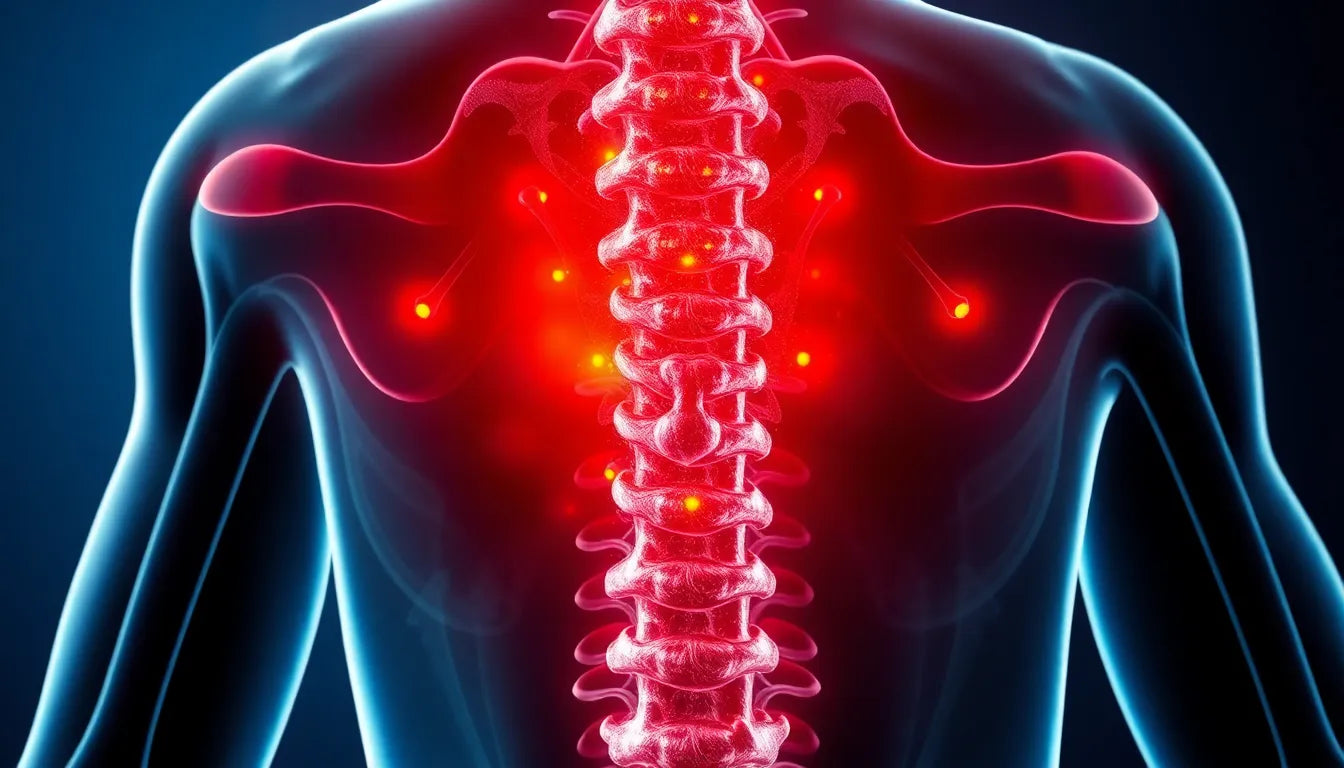Dealing with a herniated disc can be a daunting experience, especially when it disrupts your daily life with persistent pain and discomfort. A herniated disc occurs when a spinal disc ruptures, allowing its inner gel-like substance to leak out. This can lead to nerve irritation and a range of symptoms, including back pain, leg pain, and numbness. It's a common condition that affects many people, often leading them to seek solutions that can help them regain their quality of life.
Understanding herniated discs
Herniated discs are more prevalent than you might think, and they can have a significant impact on your daily activities. The spine is composed of a series of discs that act as cushions between the vertebrae, allowing flexibility and absorbing shock. When one of these discs herniates, it can press on nearby nerves, causing pain and other symptoms that can range from mild discomfort to severe agony. This condition is particularly common in the lower back and can affect individuals of all ages, although it's more frequent in middle-aged adults.
While the symptoms of a herniated disc can be debilitating, the good news is that most cases can heal without the need for surgery. This blog post focuses on exploring non-surgical paths to recovery, offering hope and practical advice for those affected. By understanding the nature of herniated discs and the various treatment options available, you can take proactive steps towards healing and regaining control over your life.
The importance of non-surgical interventions
When it comes to treating a herniated disc, there's a strong consensus among medical professionals that non-surgical treatments should be the first line of defense. These conservative approaches offer numerous benefits, including lower risk, cost-effectiveness, and the ability to manage symptoms effectively. By opting for non-surgical interventions, you can avoid the potential complications and recovery time associated with surgery.
Conservative treatments for herniated discs focus on relieving pain, reducing inflammation, and promoting healing. These methods can include physical therapy, exercise, hot and cold therapy, and rest combined with modified activity. Each of these approaches plays a crucial role in supporting the spine, alleviating pressure on the affected disc, and ultimately facilitating the healing process.
By prioritizing non-surgical interventions, you not only minimize risks but also empower yourself to take an active role in your recovery. With the right guidance and a commitment to following a tailored treatment plan, you can achieve significant improvements in your symptoms and overall well-being. In the following sections, we'll delve deeper into specific conservative treatments and explore how they can help you on your journey to healing a herniated disc without surgery.
conservative and home-based treatments for herniated discs
Embarking on the path to healing a herniated disc often begins with conservative and home-based treatments. These approaches are designed to alleviate symptoms, promote healing, and strengthen the body to prevent future injuries. A cornerstone of this strategy is physical therapy and exercise, which play a crucial role in recovery.
physical therapy & exercise
Physical therapy focuses on strengthening the core and back muscles, which are essential for supporting the spine and reducing pressure on the herniated disc. A tailored exercise regimen can help improve flexibility, enhance posture, and alleviate pain. Commonly recommended exercises include gentle stretching, core stabilization routines, and low-impact aerobic activities such as walking or swimming. These exercises not only aid in recovery but also prevent stiffness and muscle atrophy, which can occur with prolonged inactivity.
hot and cold therapy
Alternating between hot and cold therapy is another effective method for managing the symptoms of a herniated disc. Cold therapy is beneficial for reducing inflammation and numbing sharp pain, while heat therapy improves blood circulation and promotes healing by relaxing tense muscles. To apply these therapies effectively, start with cold packs for 15-20 minutes several times a day, especially after activities that exacerbate pain. Once the acute pain subsides, incorporate heat therapy using warm compresses or heating pads to soothe and relax the affected area.
rest and modified activity
While rest is important, it should be balanced with modified activity to maintain flexibility and prevent muscle weakening. Short periods of rest can help reduce inflammation, but complete bed rest is discouraged as it can lead to further stiffness and delayed recovery. Instead, focus on light activities that do not exacerbate pain, such as walking or gentle stretching, to keep the body moving and facilitate healing.
medical interventions for herniated discs
When conservative treatments are not sufficient to manage pain and discomfort, medical interventions may be considered to provide additional relief and support the healing process.
pain medications
Over-the-counter nonsteroidal anti-inflammatory drugs (NSAIDs) like ibuprofen or naproxen are commonly used to manage pain and inflammation associated with a herniated disc. In some cases, doctors may prescribe stronger medications if over-the-counter options are ineffective. It's important to use these medications as directed to avoid potential side effects.
epidural steroid injections
For individuals experiencing severe pain that doesn't respond to other treatments, epidural steroid injections can offer significant relief. These injections deliver corticosteroids directly to the affected area, reducing inflammation and pain. While the relief from these injections is typically temporary, it can allow patients to engage more fully in physical therapy and other rehabilitative activities.
surgery as a last resort
Although most herniated discs improve without surgery, it remains an option when conservative treatments fail or neurological symptoms worsen. Surgery is generally considered a last resort, with procedures like discectomy being effective for relieving leg and back pain in severe cases. However, the decision to undergo surgery should be made in consultation with a healthcare professional, considering all potential risks and benefits.
alternative and adjunct therapies
In addition to conventional treatments, alternative therapies can complement the healing process and provide additional symptom relief.
acupuncture and chiropractic care
Acupuncture is often explored for its potential to relieve pain and increase circulation, although scientific evidence on its efficacy is mixed. Chiropractic care, involving spinal manipulation, may also offer relief for some individuals, though it should be approached with caution and performed by licensed professionals.
massage therapy and gentle stretching
Massage therapy can help reduce muscle tension and improve circulation, contributing to pain relief and relaxation. Gentle stretching exercises, as part of a broader conservative treatment plan, can further enhance flexibility and support recovery.
By integrating these various approaches, individuals can create a comprehensive, non-surgical strategy to heal a herniated disc, improve quality of life, and reduce the risk of future complications.
Self-healing and recovery timeline for herniated discs
Understanding the typical recovery timeline for a herniated disc is crucial for setting realistic expectations and planning your path to healing. Most herniated discs can heal on their own or with non-surgical treatment, generally within a few weeks to several months. During this period, it is essential to monitor signs of healing, such as reduced pain, increased mobility, and the ability to gradually resume normal activities without exacerbating symptoms.
As you progress through recovery, it is important to maintain a balance between rest and activity. While some discomfort is expected, persistent or worsening symptoms should prompt a consultation with a healthcare professional. By adhering to a comprehensive treatment plan that includes physical therapy, exercise, and other conservative measures, you can optimize your recovery and reduce the likelihood of future complications.
Comparative summary of treatment options
To help you navigate the various treatment options for a herniated disc, the following table provides a comparative overview of their benefits, risks, and suitability for different stages of recovery:
| Treatment | Benefits | Risks | Suitability |
|---|---|---|---|
| Physical Therapy & Exercise | Strengthens muscles, improves flexibility | Minimal when guided by professionals | All stages |
| Hot and Cold Therapy | Reduces pain and inflammation | None if used correctly | Acute and recovery phases |
| Pain Medications | Alleviates pain and inflammation | Potential side effects with prolonged use | Acute phase |
| Epidural Steroid Injections | Provides significant pain relief | Temporary relief, potential side effects | Severe cases |
| Surgery | Effective for severe cases | Inherent surgical risks | Last resort |
When to seek medical intervention
While many herniated discs improve with conservative treatment, certain symptoms warrant immediate medical attention. Red flags include persistent or worsening pain, significant neurological deficits such as weakness or loss of sensation, and bowel or bladder dysfunction. If you experience any of these symptoms, it is crucial to seek prompt evaluation by a healthcare professional to determine the appropriate course of action.
Conclusion
Healing a herniated disc without surgery is not only possible but often the preferred approach. By embracing a multifaceted treatment plan that includes physical therapy, exercise, pain management, and alternative therapies, you can effectively manage symptoms and support the natural healing process. Patient education and active participation in recovery are key to achieving the best outcomes and preventing future issues.
Frequently Asked Questions
What is the fastest way to heal a herniated disc?
There is no single fastest way to heal a herniated disc. A combination of therapies tailored to the individual's needs is often most effective. This may include physical therapy, exercise, and pain management strategies.
Can a herniated disc heal completely?
Most herniated discs can heal over time with appropriate treatment, though some individuals may experience lingering symptoms. Consistent adherence to a treatment plan can enhance recovery.
Is it safe to exercise with a herniated disc?
Yes, exercising under the guidance of a healthcare professional can be beneficial and is often recommended. Exercise helps strengthen muscles and improve flexibility, which supports recovery.
How long should I try conservative treatment before considering surgery?
Typically, a period of 6-12 weeks is recommended before considering surgical options, unless symptoms are severe or worsening. This allows time for conservative treatments to take effect.
What lifestyle changes can support recovery from a herniated disc?
Maintaining a healthy weight, practicing good posture, and engaging in regular, low-impact exercise can all support recovery. These lifestyle changes help reduce strain on the spine and promote overall spinal health.
Sources
- "Practical Approaches to Herniated Discs." Sciatica.com.
- "Understanding Herniated Discs: Non-Surgical Treatments." Cleveland Clinic.
- "Herniated Disc Management and Treatments." NYU Langone Health.
- "Physical Therapy and Pain Management for Herniated Discs." New York Spine Surgery.
- "Natural Healing Processes for Herniated Discs." Insight Chicago.
- "Comparative Effectiveness of Surgery vs. Conservative Treatments." LWW's Medicine Journal.


















